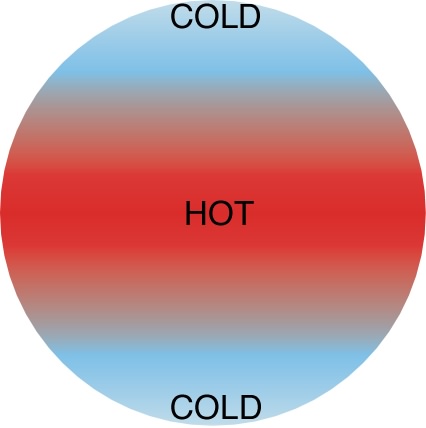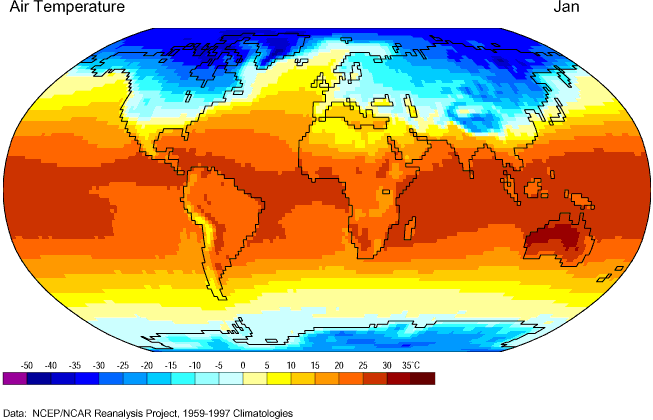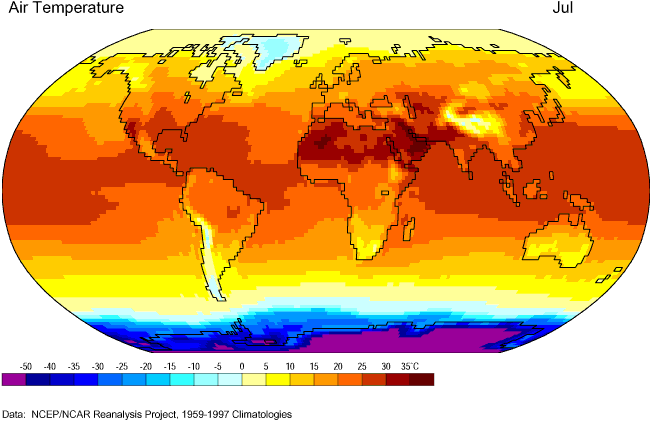If the Earth was a homogeneous body without the present land/ocean distribution, its temperature distribution would be strictly latitudinal (Figure 7m-1). However, the Earth is more complex than this being composed of a mosaic of land and water. This mosaic causes latitudinal zonation of temperature to be disrupted spatially.

Figure 7m-1: Simple latitudinal zonation of temperature.
The following two factors are important in influencing the distribution of temperature on the Earth's surface:
- The latitude of the location determines how much solar radiation is received. Latitude influences the angle of incidence and duration of daylength.
- Surface properties - surfaces with high albedo absorb less incident radiation. In general, land absorbs less insolation that water because of its lighter color. Also, even if two surfaces have the same albedo, a surface's specific heat determines the amount of heat energy required for a specific rise in temperature per unit mass. The specific heat of water is some five times greater than that of rock and the land surface (see Table 7m-1 below). As a result, water requires the input of large amounts of energy to cause a rise in its temperature.
Table 7m-1: Specific Heat of Various Substances.
|
Substance |
Specific Heat |
|
Water |
1.00 |
|
Air |
0.24 |
|
Granite |
0.19 |
|
Sand |
0.19 |
|
Iron |
0.11 |
Mainly because of specific heat, land surfaces behave quite differently from water surfaces. In general, the surface of any extensive deep body of water heats more slowly and cools more slowly than the surface of a large land body. Other factors influencing the way land and water surfaces heat and cool include:
- Solar radiation warms an extensive layer in water, on land just the immediate surface is heated.
- Water is easily mixed by the process of convection.
- Evaporation of
water removes energy from water's surface.
The following images illustrate the Earth's temperature distribution patterns for an average January and July based on 39 years of data (Figures 7m-2 and 7m-3). Note that the spatial variations of temperature on these figures is mostly latitudinal. However, the horizontal banding of isotherms is somewhat upset by the fact that water heats up more slowly in the summer and cools down more slowly in the winter when compared to land surfaces. During January, much of the terrestrial areas of the Northern Hemisphere are below freezing (Figure 7m-2). Some notable Northern Hemisphere cold-spots include the area around Baffin Island Canada, Greenland, Siberia, and the Plateau of Tibet. Temperatures over oceans tend to be hotter because of the water's ability to hold heat energy.
In the Southern Hemisphere, temperatures over the major landmasses are generally greater than 20° Celsius with localized hot-spots in west-central Australia, the Kalahari Desert in Africa, and the plains of Bolivia, Paraguay, and Argentina (Figure 7m-2). Subtropical oceans are often warmer than landmass areas near the equator. At this latitude, land areas receive less incoming solar radiation because of the daily convective development of cumulus and cumulonimbus clouds. In the mid-latitudes, oceans are often cooler than landmass areas at similar latitudes. Terrestrial areas are warmer because of the rapid heating of land surfaces under frequently clear skies. Antarctica remains cold and below zero degrees Celsius due to the presence of permanent glacial ice which reflects much of the solar radiation received back to space.

| Figure 7m-2: Mean January air temperature for the Earth's surface, 1959-1997. (Source of Original Modified Image: Climate Lab Section of the Environmental Change Research Group, Department of Geography, University of Oregon - Global Climate Animations). |
In July, the Northern Hemisphere is experiencing its summer season because the North Pole is now tilted towards the Sun (Figure 7m-3). Some conspicuous hot-spots include the south-central United States, Arizona and northwest Mexico, northern Africa, the Middle East, India, Pakistan, and Afghanistan. Temperatures over oceans tend to be relatively cooler because of the land's ability to heat quickly. Two terrestrial areas of cooler temperatures include Greenland and the Plateau of Tibet. In these regions, most of the incoming solar radiation is sent back to space because of the presence of reflective ice and snow.
In the Southern Hemisphere, temperatures over the major landmasses are generally cooler than ocean surfaces at the same latitude (Figure 7m-3). Antarctica is bitterly cold because it is experiencing total darkness. Note that Antarctica is much colder than the Arctic was during its winter season (Figures 7m-2 and 7m-3). The Arctic consists mainly of ocean. During the summer, this surface is able to absorb considerable quantities of sunlight which is then converted into heat energy. The heat stored in the ocean is carried over into the winter season. Antarctica has a surface composed primarily of snow and ice. This surface absorbs only a small amount of the solar radiation during the summer. So it never really heats up. As a result, the amount of heat energy stored into the winter season is minimal.

| Figure 7m-3: Mean July air temperature for the Earth's surface, 1959-1997. (Source of Original Modified Image: Climate Lab Section of the Environmental Change Research Group, Department of Geography, University of Oregon - Global Climate Animations). |
Figure 7m-4 describes average annual global temperature data for the Earth for the period 1982-1994. The patterns of temperature distribution on this figure are once again mostly latitudinal. However, the latitudinal banding is partially upset by the fact that water bodies are generally warmer than land surfaces. The image also shows the effect of altitude (e.g., Himalayas and Andes mountains) and albedo (Greenland and Antarctica) on surface air temperature.
Average Annual Global Temperature 1982-1994
Temperature Scale in Kelvin
Figure 7m-4: Average annual temperatures for the Earth's surface (1982-94).
(Image generated by WorldWatcher software).